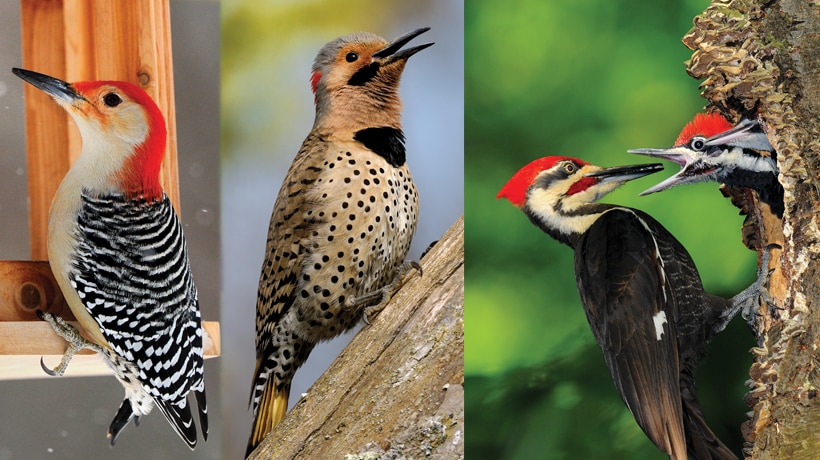Exploring Woodpeckers in Florida Habitats: Where to Spot These Birds
Exploring Woodpeckers in Florida Habitats: Where to Spot These Birds
Blog Article
Woodpeckers Unleashed: Discovering the Wonders of These Proficient Tree Climbers
Woodpeckers, with their distinctive markings and rhythmic drumming resembling via wooded areas, hold a special area in the avian globe - Woodpeckers in Florida. As we dive into the elaborate details of woodpeckers' nesting practices, feeding strategies, and the ongoing conservation initiatives to shield these remarkable birds, a deeper recognition for their area in nature unfolds.
Anatomy and Adaptations
When examining the anatomy and adjustments of woodpeckers, one can observe amazing features that enable these birds to grow in their specialized eco-friendly specific niche. Woodpeckers are furnished with a collection of distinct physiological features that help them in their woodpecking behavior. One of one of the most prominent features is their strong, chisel-like beak, which is specialized for drilling into timber to reveal pests or create nesting cavities. This beak is supported by solid neck muscular tissues and a highly created head framework that works as a shock absorber, permitting woodpeckers to repeatedly peck at trees without creating mind injury. In addition, woodpeckers have zygodactyl feet, with 2 toes encountering onward and 2 dealing with backwards, offering a firm grip on tree trunks while they search for food or drum for interaction.
Additionally, woodpeckers have a distinct tongue structure that is long, barbed, and sticky, allowing them to draw out insects from holes in wood. This specialized adjustment allows woodpeckers to manipulate a food resource that is inaccessible to several other bird species. On the whole, the composition and adaptations of woodpeckers display the amazing evolutionary options that have permitted these birds to thrive in their arboreal habitat.
Drumming Actions
Having explored the makeup and adjustments of woodpeckers, the focus now moves to recognizing their drumming habits, a distinctive aspect of their interaction and territorial displays. Drumming is a vital type of communication among woodpeckers, serving multiple functions such as establishing areas, bring in companions, and signaling alarm system. Each woodpecker species has a special drumming pattern that helps individuals identify members of their own varieties and distinguish them from competitors or killers.
Woodpeckers produce drumming noises by swiftly pecking on powerful surfaces such as dead trees, utility posts, or perhaps metal items, developing a series of rhythmic beats. The intensity and speed of drumming can vary based upon the purpose; for example, a fast drumming series might signify hostility in the direction of burglars, while a slower and softer drumming pattern could indicate courtship (Woodpeckers in Florida). Furthermore, woodpeckers might readjust the regularity and duration of their drumming to convey particular messages properly
Nesting Habits
Exploring the nesting practices of woodpeckers exposes remarkable understandings right into their reproductive actions and environment choices. Woodpeckers are known for their distinct nesting preferences, usually excavating cavities in trees to create sheltered spaces for raising their young. These tooth cavities serve not only as a nesting site but also as a safe and secure refuge from killers and severe weather condition.
Woodpeckers exhibit a high degree of fidelity to their nesting sites, often returning to the same area time after time. This habits highlights the value of ideal habitat schedule for their reproductive success. The choice of a nesting website is vital for woodpeckers, with variables such as tree types, height, and decay stage playing substantial duties in their decision-making process.
Interestingly, some woodpecker species are recognized to dig deep into several cavities within their territory, giving themselves with different nesting choices. This technique might offer as a type of insurance versus prospective risks or disturbances to their key nesting website.

Feeding Methods
Woodpeckers use a selection of specialized feeding techniques to obtain their main food resources. Among one of the most distinctive feeding see here now habits of woodpeckers is drumming, which includes fast pecking on trees to reveal pests beneath the bark. This drumming not only assists them find victim yet additionally works as a means of communication with other woodpeckers. Woodpeckers have strong, chisel-like beaks that allow them to drill into wood easily. As soon as an opening is created, they utilize their lengthy, barbed tongues to remove bugs such as ants, beetles, larvae, and spiders. These tongues are coated with sticky saliva that assists trap the victim. Woodpeckers are likewise understood to excavate tooth cavities in trees to gain access to concealed insect larvae or sap. Some species, like the acorn woodpecker, shop nuts in particularly created openings called granaries. This strategic keeping of food aids them survive throughout food shortage durations. Woodpeckers are really amazing in their feeding methods, showcasing versatility and intelligence in procuring their nourishment.
Conservation Initiatives
In the middle of the elaborate feeding techniques showed by woodpeckers, the preservation efforts focused on securing these interesting birds play an important role in preserving their environments and populations. Woodpeckers face numerous risks to their survival, including environment loss due to logging, climate adjustment altering their communities, and crashes with manufactured structures such as structures and vehicles - Woodpeckers in this content Florida. Preservationists are actively functioning to deal with these obstacles and guarantee the lasting wellness of woodpecker varieties

Education and learning and public understanding campaigns are also vital components of woodpecker preservation initiatives. By raising awareness regarding the significance of these birds in maintaining healthy and balanced forest ecological communities, guardians can garner assistance for habitat preservation initiatives and advertise responsible land monitoring methods. Via collective initiatives between scientists, policymakers, and local neighborhoods, we can interact to secure a future where woodpeckers prosper in their all-natural habitats.
Verdict

Report this page